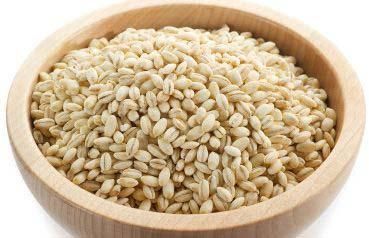- Barley’s role in Islamic literature for nutrition, medicinal properties, and recommended consumption.
- Modern efforts focus on reintroducing barley, considering its immediate benefits amidst scarcity.
- Scientific studies identify barley’s impact on cell health, aging, and potential therapeutic uses.
Evidence of the beginning of cultivated barley goes back to the Middle East, 6,000 years ago. The 5th largest cultivated cereal crop in the world still bears some relations with the wild variety Hordeum spontaneum still grown in Iran and Iraq today.
Considered to be the most drought and saline tolerant of cereals, its wide-ranged geographical distribution has led to many varieties (CGIAR p.1).
The ancient grass barley is no longer available due to environmental conditions making food a scarce commodity. The consortium will re-introduce barley and other cereals including genetically ‘improved’ seeds, but it is the hardy barley that would provide the most benefit right now (ICARDA p.1, 2).
Barley in Islamic Literature
Viewed as the only vegetation on earth that can become a sole source of nutrition from birth to old age, scholars of hadiths (prophetic sayings) have understood barley to be very nutritious, beneficial in coughs and inflammation of the stomach, and to have the ability to expel toxins from the body and act as a good diuretic.
At least twenty-one hadiths recommend sattoo (powdered barley). Talbina is a meal that contains satoo, milk and honey.
The Prophet Muhammed (PBUH) recommended talbina for the sick and grieving (Khan p.1). He said, “ At-talbina gives rest to the heart of the patient and makes it active and relieves some of his sorrow and grief” (Bukhari 7:71#593).
According to Ibn al-Qayyim, barley water using five times the amount of water as barley, should be boiled until the contents reduce to three-quarters. This milky mixture is a thirst quencher.
While for Firdous Al-Hikmat, a suspension prepared from one part barley and 15 parts water until the volume is reduced to two-thirds after boiling is beneficial (Khan p.1-3). In fact, the Japanese drank the pure juice from young barley leaves in powdered form for a number of years (Hagiwara p.4). Also, science has proven the benefits of all of this and more.
Rediscovering Barley in Modern Research

Like most major crops grown today in the U.S., barley originated from the Middle East; and like most Western countries, barley is an animal feed with the high quality barley enters the production of beer and other alcoholic beverages (Levin p.1). Saudi Arabia is the world’s largest feed barley importer (Lee p.3).
As a food, barley’s long list of benefits include: 18 amino acids of which eight are the essential amino acids that the human body cannot produce, sodium, potassium, calcium, magnesium antioxidants, glucan, iron, copper, phosphorus, manganese, zinc, beta carotene, vitamins B1, B2, B6, C, folic acid and pantothenic acid. It also contains amylase, dextrin, phospholipids, maltose, glucose, sulfur, niacin and protein (herbsrainbear.com p.1).
In fact, Dr. Howard Lutz of the Institute of Preventative Medicine in Washington admires the properties of this grass. He referred to it as “…the most incredible product of this decade. It improves stamina, sexual energy, clarity of thought and reduces addiction to things that are bad for you.”
Now maybe one can better understand why the Prophet (PBUH) advised its consumption for the sick and grieving. After all, it is at these times that one’s poor appetite can encourage further illness or even cause one to seek satisfaction from harmful substances. If one’s mind is clear, one is also better able to respect the cycle of life.
Moreover, Dr. Yoshihide Hagiwara, a plant geneticist who became disillusioned with the side effects of modern drugs, researched 150 types of barley over a 15-year period.
Hagiwara, working at the Office of Science and Technology and Japan Food Analysis Center, discovered that the high organic sodium content of barley keeps calcium in solution form in the bloodstream and it actually dissolves calcium deposits in the joints.
Barley also replaces the organic sodium of the stomach lining, which assists digestion by improving the hydrochloric acid in the stomach. The enzyme superoxide dismutase, SOD, was isolated from barley and has been found to be a powerful antioxidant that protects the cells against the disease-causing free radicals that destroy healthy cells (Wheatgrass.com p.1, 2).
With no known contraindications, barley has been a remedy for indigestion, diarrhea, and inflammatory conditions of the stomach and bowels. The soothing effect on the digestive tract originates from the grain itself when the husk is removed (Yahoo p.1).
Fresh Barley, Powdered Barley, Barley Juice and Barley Soup!
Hazim asked Sahl, “Did you use white flour during the lifetime of the Prophet?” Sahl replied, “No.” Hazim asked, “Did you used to sift barley flour?” He said, “No, but we used to blow off the husk (of the barley)” (Bukhari 7:65 #321).
This shows knowledge of how best to get the benefits from barley. As a slow digesting food, it is recommended during the fasts of Ramadan when one’s diet should differ from one’s normal diet in simplicity.
Furthermore, in traditional Chinese herbal medicine, the dried or germinated shoots of the common variety, Hordeum vulgare, are used to improve poor digestion as the result of a weak spleen and abdomen, anorexia and abdominal distension.
Combined with hawthorn fruit, it stops milk secretions and painful breasts and is thus not recommended for lactating women. It is also ill advised for pregnant women as it promotes contractions. It is of benefit, however, during the process of childbirth (Reid p.136).
Barley water using 3 tablespoons of barley boiled in 3 cups of water for one hour and then strained and cooled is placed on the face as a skin freshener, meanwhile cleansing and softening normal skin. After rinsing, any left over water can be refrigerated. Drinking barley water clears the skin.
Also, honey and orange juice can be added to make it more palatable (herbsrainbear p.1, 2). Added to diluted cow’s milk, it becomes a nutritional drink for young children (Yahoop.1).
Pages: 1 2